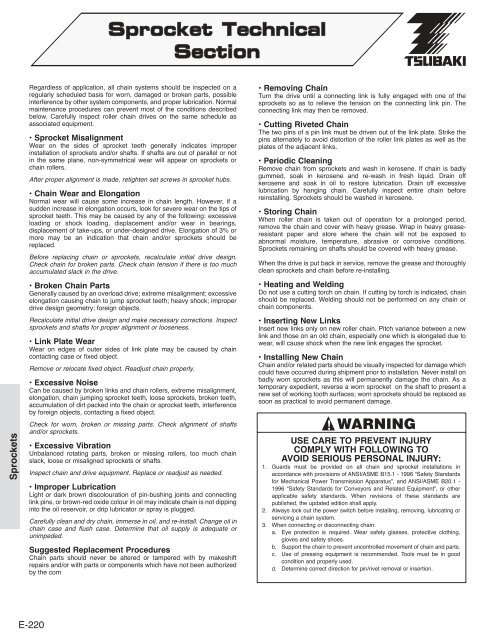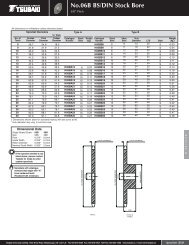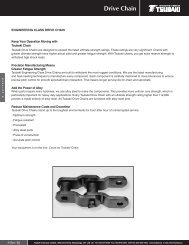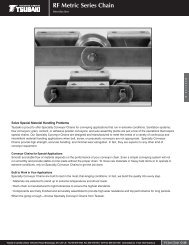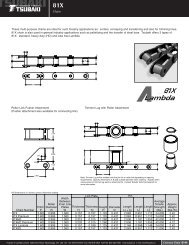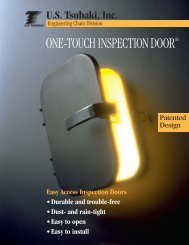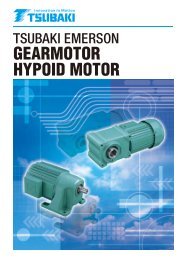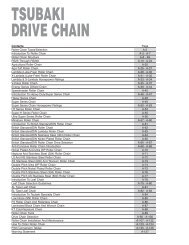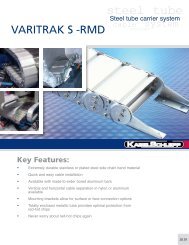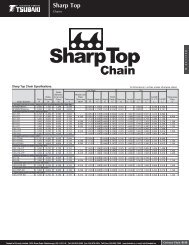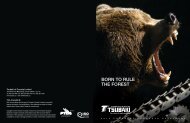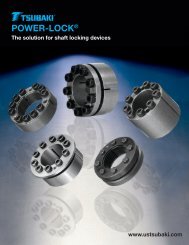Made-to-Order Sprockets - Tsubaki
Made-to-Order Sprockets - Tsubaki
Made-to-Order Sprockets - Tsubaki
Create successful ePaper yourself
Turn your PDF publications into a flip-book with our unique Google optimized e-Paper software.
Sprocket TechnicalSection<strong>Sprockets</strong>Regardless of application, all chain systems should be inspected on aregularly scheduled basis for worn, damaged or broken parts, possibleinterference by other system components, and proper lubrication. Normalmaintenance procedures can prevent most of the conditions describedbelow. Carefully inspect roller chain drives on the same schedule asassociated equipment.• Sprocket MisalignmentWear on the sides of sprocket teeth generally indicates improperinstallation of sprockets and/or shafts. If shafts are out of parallel or notin the same plane, non-symmetrical wear will appear on sprockets orchain rollers.After proper alignment is made, retighten set screws in sprocket hubs.• Chain Wear and ElongationNormal wear will cause some increase in chain length. However, if asudden increase in elongation occurs, look for severe wear on the tips ofsprocket teeth. This may be caused by any of the following: excessiveloading or shock loading, displacement and/or wear in bearings,displacement of take-ups, or under-designed drive. Elongation of 3% ormore may be an indication that chain and/or sprockets should bereplaced.Before replacing chain or sprockets, recalculate initial drive design.Check chain for broken parts. Check chain tension if there is <strong>to</strong>o muchaccumulated slack in the drive.• Broken Chain PartsGenerally caused by an overload drive; extreme misalignment; excessiveelongation causing chain <strong>to</strong> jump sprocket teeth; heavy shock; improperdrive design geometry; foreign objects.Recalculate initial drive design and make necessary corrections. Inspectsprockets and shafts for proper alignment or looseness.• Link Plate WearWear on edges of outer sides of link plate may be caused by chaincontacting case or fixed object.Remove or relocate fixed object. Readjust chain properly.• Excessive NoiseCan be caused by broken links and chain rollers, extreme misalignment,elongation, chain jumping sprocket teeth, loose sprockets, broken teeth,accumulation of dirt packed in<strong>to</strong> the chain or sprocket teeth, interferenceby foreign objects, contacting a fixed object.Check for worn, broken or missing parts. Check alignment of shaftsand/or sprockets.• Excessive VibrationUnbalanced rotating parts, broken or missing rollers, <strong>to</strong>o much chainslack, loose or misaligned sprockets or shafts.Inspect chain and drive equipment. Replace or readjust as needed.• Improper LubricationLight or dark brown discolouration of pin-bushing joints and connectinglink pins, or brown-red oxide colour in oil may indicate chain is not dippingin<strong>to</strong> the oil reservoir, or drip lubrica<strong>to</strong>r or spray is plugged.Carefully clean and dry chain, immerse in oil, and re-install. Change oil inchain case and flush case. Determine that oil supply is adequate orunimpeded.Suggested Replacement ProceduresChain parts should never be altered or tampered with by makeshiftrepairs and/or with parts or components which have not been authorizedby the com• Removing ChainTurn the drive until a connecting link is fully engaged with one of thesprockets so as <strong>to</strong> relieve the tension on the connecting link pin. Theconnecting link may then be removed.• Cutting Riveted ChainThe two pins of a pin link must be driven out of the link plate. Strike thepins alternately <strong>to</strong> avoid dis<strong>to</strong>rtion of the roller link plates as well as theplates of the adjacent links.• Periodic CleaningRemove chain from sprockets and wash in kerosene. If chain is badlygummed, soak in kerosene and re-wash in fresh liquid. Drain offkerosene and soak in oil <strong>to</strong> res<strong>to</strong>re lubrication. Drain off excessivelubrication by hanging chain. Carefully inspect entire chain beforereinstalling. <strong>Sprockets</strong> should be washed in kerosene.• S<strong>to</strong>ring ChainWhen roller chain is taken out of operation for a prolonged period,remove the chain and cover with heavy grease. Wrap in heavy greaseresistantpaper and s<strong>to</strong>re where the chain will not be exposed <strong>to</strong>abnormal moisture, temperature, abrasive or corrosive conditions.<strong>Sprockets</strong> remaining on shafts should be covered with heavy grease.When the drive is put back in service, remove the grease and thoroughlyclean sprockets and chain before re-installing.• Heating and WeldingDo not use a cutting <strong>to</strong>rch on chain. If cutting by <strong>to</strong>rch is indicated, chainshould be replaced. Welding should not be performed on any chain orchain components.• Inserting New LinksInsert new links only on new roller chain. Pitch variance between a newlink and those on an old chain, especially one which is elongated due <strong>to</strong>wear, will cause shock when the new link engages the sprocket.• Installing New ChainChain and/or related parts should be visually inspected for damage whichcould have occurred during shipment prior <strong>to</strong> installation. Never install onbadly worn sprockets as this will permanently damage the chain. As atemporary expedient, reverse a worn sprocket on the shaft <strong>to</strong> present anew set of working <strong>to</strong>oth surfaces; worn sprockets should be replaced assoon as practical <strong>to</strong> avoid permanent damage.!WARNINGUSE CARE TO PREVENT INJURYCOMPLY WITH FOLLOWING TOAVOID SERIOUS PERSONAL INJURY:1. Guards must be provided on all chain and sprocket installations inaccordance with provisions of ANSI/ASME B15.1 - 1996 “Safety Standardsfor Mechanical Power Transmission Apparatus”, and ANSI/ASME B20.1 -1996 “Safety Standards for Conveyors and Related Equipment”, or otherapplicable safety standards. When revisions of these standards arepublished, the updated edition shall apply.2. Always lock out the power switch before installing, removing, lubricating orservicing a chain system.3. When connecting or disconnecting chain:a. Eye protection is required. Wear safety glasses, protective clothing,gloves and safety shoes.b. Support the chain <strong>to</strong> prevent uncontrolled movement of chain and parts.c. Use of pressing equipment is recommended. Tools must be in goodcondition and properly used.d. Determine correct direction for pin/rivet removal or insertion.E-220


